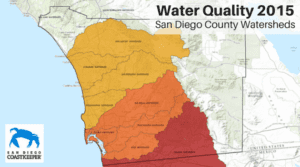Every year, Heal the Bay puts out a beach report card, providing essential water quality information to the millions of people who swim, surf or dive in the coastal waters of the West Coast. The report card assigns A-to-F letter grades to 456 California beaches for three reporting periods in 2015-2016, based on levels of weekly bacterial pollution.
This year, San Diego led Heal the Bay’s honor roll with an A+ grade and many are attributing the drought for these “stellar” results. But while the test results for the coastal waters are looking better than usual, not all waters are making the grade.


Inland Water Quality Vs. Coastal Water Quality
It’s all the same right? Actually, the water quality of our inland waters is worsening, partially due to very low water levels.
Our 2015 data reveal that more than three quarters of our water samples contained unsafe levels of fecal indicator bacteria. This means that our rivers and streams are carrying pollutants to the ocean that cause health problems like staph infections, ear aches, stomach issues, rashes, eye infections and cysts — just to name a few.
The fact that there has not been any rain to move the poor quality water may be the cause behind San Diego’s A+ grade. But, if the much-needed rain came and washed all the pollutants and bacteria into the ocean, it would stand to reason that San Diego would not be on the honor role.
Truly Improving Water Quality
The only real way to improve our water quality is to stop pollution and runoff at the source. Coastkeeper also works to stop industrial pollution, urban runoff, sewage spills and more.
We have successfully reduced beach advisories by 77 percent since 2000 and continue to work on making our inland and coastal waters swimmable and fishable. While the coastal waters are better today, our inland waters are a sure sign that overall there is more work to do.













